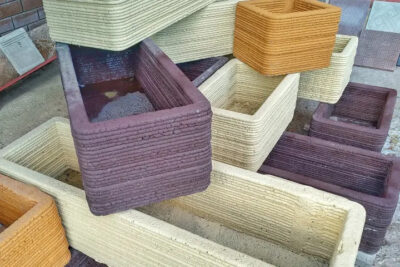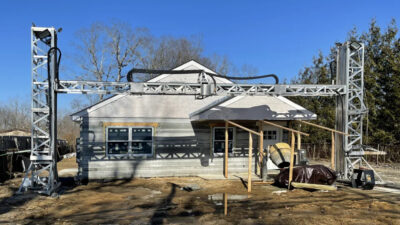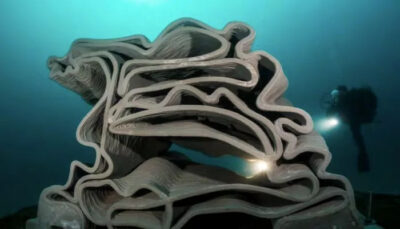3D printed houses, artistic pieces, and statues
Executive summary
Robots and automation are required in the construction industry to boost production and address these escalating difficulties. Construction firms and home builders alike are looking for a realistic solution for rapidly constructing robust homes at a lower cost and higher, consistent quality. Additionally, critical trades in the construction sector are expensive and scarce. This has resulted in operational setbacks.
Despite the challenges, experts are optimistic that 3D printing would be the future of construction. The current challenges posed are common barriers that any new technology faces when launched in the market. They are most likely to resolve over time with testimonies of success. The equipment cost will come down with widespread acceptance, more people would be trained to operate it and the benefits would outweigh the challenges by far. Thus, we can say that 3D printing technology is not a flickering trend but the future of the construction industry.
Introduction – The Current Trends
In light of the global developments of “labor and housing shortages“, increasing productivity is a significant challenge for the construction industry. 3D construction printing technology addresses precisely these issues.
Technology startup revolutionizing the 3DCP – 3D Construction / Concrete Printing (3DCP) industry presents not only concrete printing but also integral, automated reinforcement, formworks and insulations solutions. It encompasses a group of experienced engineers, architects, entrepreneurs, visionary personalities who met to the way of building.
In light of the global developments of “labor and housing shortages”, increasing productivity is a significant challenge for the construction industry. 3D construction printing technology, as an automated and additive manufacturing process, addresses precisely these issues. Our focus is primarily on the segments of residential construction and individual prefabricated parts.
Despite the hype over 3DCP, there are a lot of misconceptions to the technology. As of 2019, no building can be printed in 24 hours, despite what news headlines say. Additionally, an entire building is not built completely from 3DCP technologies. Usually, only the walls are 3D printed while Roofs, slabs and floors still need to be made the traditional way; similar for plastering, painting, cabling and plumbing. In general, 3D printing only takes care of the 20-25%, which the walls make up of an entire building, while conventional methods are still responsible for the remaining 75-80%.
Construction 3D printing has come a long way in the last decade from being just a pipe dream to an actual available service. Construction 3D printing has thus far flourished by and large in the prefabricated houses market. Slowly and surely, mobile construction 3D printers are gaining both the stability as well as the quality needed to cope with printing on-site, and on-location in a variety of construction conditions.
Key Benefits of 3DCP
The acronym 3DCP usually refers to 3D Concrete Printing as concrete being the most common material for such applications in construction and architecture. However, other materials can be used, including those who have a lower carbon footprint.
Methods of Construction 3D Printing
Based on the method of construction, 3D printed houses right now fall into two categories: Modular/Off-site 3D Printed Houses and On-site 3D Printed Houses.
With the accuracy and resolution of construction 3D printing comes the ability of 3D printing a complete house, in parts, off-site and then later transporting and assembling the same onto the final location. Many 3D construction printer companies have made this into a viable business model. On-site 3D printed houses promise far greater disruption in the housing and construction industry than off-site ones. The primary reason is that on-site construction 3D printing actively takes business away from conventional construction technology. The savings in labor cost, and just the sheer amazement of seeing an entire habitable house get constructed in a matter of days instead of months means that on-site 3D printed houses have a bigger audience to cater to before even completely hitting the market.
Prefab, modular methods are more preferable if centralized fabrication is the business model, where parts are produced in another location, post-processed and shipped to the site for installation. It is also the method done mostly for large-scale building. Alternatively, on-site 3D printing provides more robust designs and fabrication of rapid small homes, blocks, statues, etc. with no need for warehouse or significant installation costs. This can be mixed with prefabs where parts are produced close to the site.
Modular/Prefab Construction 3D Printing
The advantages that come with 3D printing off-site include:
• Much greater control over the 3D printing process
• Less risk of damage to the expensive construction 3D printing equipment
• Permanently installed construction 3D printers
• Increased worker safety
• Greater design freedom
• Cost Savings
While prefab construction 3D printed housing certainly has plenty of positives going for it, certain drawbacks have kept it from becoming the housing revolution that is so needed in today’s world. Some of those draw backs include:
• Unpredictable durability
• Costs of Assembly
• Increased Lead Times
• Risk of Damage On the Road
• Limited reach
• The “Mobile Home” Stigma (lower income marker only)

Prefab Concrete Structures
On-Site Construction 3D Printing
On-site construction 3D printing is now being hailed as the future of construction as a whole by a lot of industry experts, its advantages include:
• Increased Apparent Durability
• Adaptable Design
• Cost Savings are transferred
• Flexible Construction Materials
• Time Savings
• Greater reach
While on-site construction 3D printing is poised as the future of home building, it still has some drawbacks that have yet to be overcome. These disadvantages of on-site construction 3D printing include:
• Loss of printing quality
• More expensive failure
• Higher risk to construction 3D printing equipment: Printing on-
• Less Safety for Workers
• Construction Regulations or lack thereof
• Expensive Site Preparation

On-Site Construction 3D Printing
3DCP Outside the AEC Industry
Obviously, 3DCP has been used famously for fabricating houses and buildings, working hand in hand with Architecture, Engineering and Construction (AEC) companies. However, it has been used for different applications as well.
Military & Conflict/Disaster Zones
Military and other government agencies can utilize this technology to print concrete barracks, bunkers and other structures in challenging environments. This new field has also drawn up plans to create 3D-printed vehicle bridge, where their priority was to develop a capability that utilizes 3D printing technology for use in an expeditionary environment. These constructs are also sustainable and safe, tolerating extremes of weather conditions and natural disasters. For zones with difficult terrain, it can help into rebuilding temporary roads for evacuations and assisting in strategic operations.
3D Printed Artificial Coral Reef
Coral reefs have existed for 485 million years and occupy about 284,300 km2, which is equivalent to around half the area of France. They provide shelter for at least 25% of all marine species, including fish, molluscs, worms, crustaceans, sponges, and more. However, gradual deterioration by bioerosion over the years, alongside bleaching events and mass mortality between the years 2015 and 2016, have put the local coral community at risk.
The 3D printed reef tiles are designed to prevent sedimentation build up, which is one of the major threats for coral reefs. A tailored algorithm was used to print the biomimicry patterns integrated with spaces for securing coral fragments. Investors hope that this new method for creating artificial reef tiles will help to restore corals and conserve biodiversity more effectively, becoming a vital contribution to ongoing global efforts to save the degraded coral reef systems in metropolises.

Artificial Reef made by 3D Concrete Printing
Space
3DCP has been commissioned to advance space exploration missions. This work will exploit an array of disciplines such as materials, aerospace and mechatronics engineering to realize complex architectural concepts that would have been unfeasible to achieve in space before the advent of 3DCP Techniques.
The process of making and 3D printing structures could lead to astronauts living on Mars or the Moon for up to a year and there’s hope their findings could impact construction on Earth. Stakeholders are already building Mars habitats for a simulation study on earth to see how the constructs will house the crew and the building would hold up under simulated conditions.
Summary & Outlook
While 3D printing’s emergence in the construction industry is ongoing, certain building aspects are poised for more growth than others. Concrete, specifically, is one of them. In fact, the concrete 3D printing market is projected to be valued at $56.4 million by 2021, growth that’s largely spurred by the amount of new, innovative projects that are being planned in construction.
As the industry faces increasing pressure to meet tight schedules and budgets, companies are looking to new innovations to help fill the gaps. 3D printing in construction offers a significant potential to increase efficiency in the building sector. Despite the benefits and potential that 3D printing has in the construction sector, there are a number of factors that may prohibit the technology from becoming mainstream, mainly high cost, skilled labor force, regulation and quality control.
At MetaMetry, we revolutionize the way we build today by combining 3D construction printing technology with digital construction & architecture design. We are convinced that 3D construction printing will gain importance & strongly drive the industrialization of the construction process, from artistic statues to full design freedom in 3D buildings.



